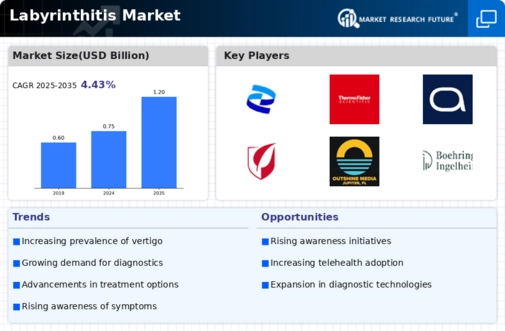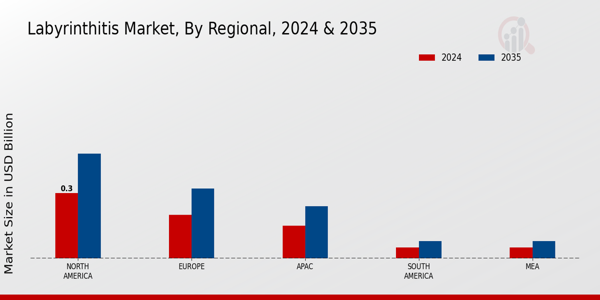Market Growth Projections
The Global Labyrinthitis Market Industry is projected to experience substantial growth over the next decade. With an expected market value of 0.75 USD Billion in 2024, the industry is anticipated to expand at a CAGR of 4.37% from 2025 to 2035, ultimately reaching an estimated 1.2 USD Billion by 2035. This growth trajectory suggests a robust demand for labyrinthitis-related healthcare services and interventions, driven by factors such as rising incidence rates, advancements in diagnostics, and increased awareness of vestibular disorders. The market's expansion reflects the evolving landscape of healthcare and the need for effective management of labyrinthitis.
Rising Incidence of Ear Infections
The increasing prevalence of ear infections globally appears to be a primary driver for the Global Labyrinthitis Market Industry. Ear infections, particularly in children, can lead to labyrinthitis if left untreated. Statistics indicate that approximately 20 percent of children experience at least one ear infection by the age of three. This rising incidence is likely to contribute to the market's growth, projected to reach 0.75 USD Billion in 2024. As awareness of the complications associated with untreated ear infections grows, healthcare providers may increasingly focus on early diagnosis and treatment, further propelling the demand for labyrinthitis-related healthcare services.
Advancements in Diagnostic Techniques
Technological advancements in diagnostic techniques are significantly influencing the Global Labyrinthitis Market Industry. Enhanced imaging technologies, such as MRI and CT scans, allow for more accurate and timely diagnosis of labyrinthitis. These innovations facilitate early intervention, which is crucial for effective treatment. As healthcare systems worldwide adopt these advanced diagnostic tools, the market is expected to benefit from increased patient referrals and treatment rates. The market is projected to grow at a CAGR of 4.37% from 2025 to 2035, reaching an estimated value of 1.2 USD Billion by 2035, reflecting the positive impact of these advancements.
Growing Awareness of Vestibular Disorders
There appears to be a growing awareness of vestibular disorders, including labyrinthitis, among both healthcare professionals and the general public. This heightened awareness is likely to lead to increased diagnosis and treatment of labyrinthitis cases, thereby driving the Global Labyrinthitis Market Industry. Educational campaigns and resources provided by health organizations are instrumental in informing individuals about the symptoms and potential complications of vestibular disorders. As more people recognize the importance of seeking medical attention for these conditions, the demand for labyrinthitis-related healthcare services is expected to rise, contributing to the market's overall growth.
Aging Population and Associated Health Issues
The aging global population is a significant factor contributing to the growth of the Global Labyrinthitis Market Industry. Older adults are more susceptible to various health issues, including labyrinthitis, due to age-related changes in the immune system and increased incidence of chronic conditions. As the demographic shift continues, with projections indicating that by 2035, nearly 1.2 billion people will be aged 60 and older, the demand for labyrinthitis treatment is likely to increase. This trend underscores the necessity for healthcare systems to adapt and expand their services to cater to the needs of an aging population, thereby fostering market growth.
Increased Investment in Healthcare Infrastructure
Investment in healthcare infrastructure is another critical driver of the Global Labyrinthitis Market Industry. Governments and private entities are increasingly allocating resources to enhance healthcare facilities and services, particularly in developing regions. This investment is likely to improve access to diagnostic and treatment options for labyrinthitis, thereby increasing patient outcomes. As healthcare systems evolve and expand, the market is expected to benefit from improved service delivery and patient care. The anticipated growth in the market, reaching 0.75 USD Billion in 2024, reflects the positive impact of these investments on labyrinthitis management.


















